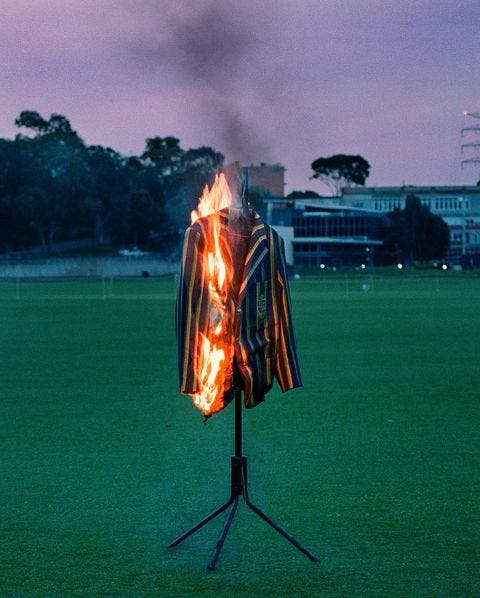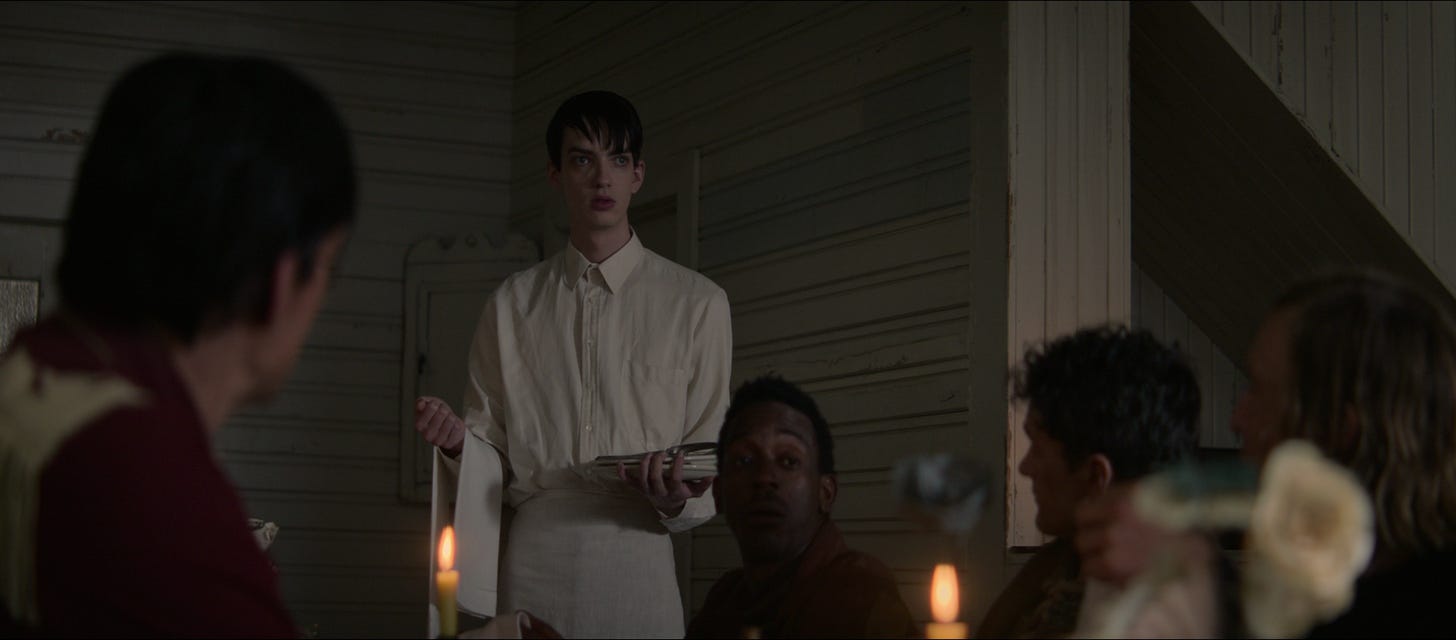The Power of the Dog is a deconstruction of masculinity
James J. Robinson on the cage that binds us all
You’re reading Scene & Heard, a weekly newsletter where I chat to a guest writer about the one scene from a recent Netflix release that left them floored. It’s part of Netflix Pause, a publication that’s all about hitting pause to reflect on the latest film and TV. Subscribe now to get it in your inbox every week diving into screen culture.
I’m Joseph Lew, editor of Netflix Pause, and growing up, I hated school. I spent many of my formative years in a same-sex space, a hyper-masculine breeding ground for homophobia, sexism and misogyny, which often left me feeling isolated, uncomfortable and disgusted.
Which is why I felt profoundly moved when I came across James J. Robinson’s work. Earlier this year, James made waves across social media when he posted an image of a burning school blazer – an act of protest against an overwhelmingly toxic male culture.
For this week’s Scene and Heard, I chat to the photographer on the one scene in The Power of the Dog that captures the stranglehold of masculinity, before unpacking his own experiences growing up in these hyper-masculine environments.

JL: Jane Campion’s back with The Power of the Dog, a meditative slow burn on toxic masculinity. And this scene you’ve chosen here is the moment where all the gears are really set into motion...
JJR: It's the first time that Phil (Benedict Cumberbatch) who very much plays this masculine archetype of the cowboy, encounters Peter (Kodi Smit-McPhee), who is working with his mom's restaurant as a waiter. And in this scene, he openly bullies him in front of his other similarly masculine prototype men.
Earlier, we see Peter creating these beautiful delicate flowers using pieces of paper which are displayed in the restaurant where his mother works. In this scene, when Peter comes out of the kitchen, he presents himself as quite feminine – as a very different kind of man compared to the rest of the people on the table. Phil starts to make fun of Peter for the way that he's holding himself, for the way that he drapes a napkin over his arm, and for the way that he attends to the table. And when he leaves the room, Phil proceeds to burn the flowers that he had created, which I thought was a really beautiful, powerful metaphor.
Upon my first watching, it triggered a lot of memories of me from school. A lot of this unspoken tension that exists between super masculine prototypes and people who don’t really identify as super masculine, which in my case, is how I identify.
The burning of the flowers is very symbolic, it’s an act of protest against Peter’s femininity. But in your case, the burning was a protest of a different kind.
In The Power of the Dog, it was meant as a very aggressive action. We have this super masculine figure whose masculinity is threatened by the presence of someone who's more feminine. And his response to that is to do something filled with a lot of rage, because it sparks something within himself that is internalised and quite deep.
For me, my protest of burning the blazer didn’t come from so much of an aggressive place, it came from more of a place of healing. I wanted to burn down what hyper-masculine spaces like the same-sex school that I attended represented. Phil’s action was intended to provoke in a negative way and to assert dominance and power, whereas mine was more peaceful, symbolising a regeneration and rising from the ashes. They are two very different sides of the masculine equation in that sense.
In your Instagram caption, you mentioned how isolated environments such as schools can act as a bubble for oppression. I guess the same could be said for Montana too, where there’s no room to be anything other than this traditional macho cowboy.
The power of the film is that it exists within this western genre. Western films are always something that I've been quite detached from, because I don't really relate to a lot of the characters and to the overt masculinity that a lot of the characters exhibit. I think Montana, as well as the western genre, represents what masculinity used to be in the past. Because of that, a western film isn't really a space for a feminine male character. Which is why I think what The Power of the Dog does is really beautiful – Peter exists as a feminine person in Montana’s very hyper-masculine space. Watching Peter’s existence was redolent of my own experience.
For myself, I’d try to hide my femininity wherever it was possible because that femininity wasn't only a threat to other people around me, but also was a threat to me and how I could exist in that space. And so, for me in school, when super masculine things are going on, like when the guys who were the most overtly masculine in the space would bully other people, my immediate response was just to laugh along and not call it out. And I think that was because I didn't really have the language, or my identity was so fragile at the time. I didn't want to put myself in the spotlight, and I didn't want to be someone who could become a target.
One really interesting parallel was this one line where Phil talks about wanting to turn Peter into a real man. In my school, we had classes called being a man. And the whole point of those was to reiterate the idea that as a man you need to provide, and that men don't cry, men don't ask for help. That moment brought me back to school and really made me question, well, what is a real man? And if I don't fit what a real man is, then what does that make me?
On that point of ‘What is a real man?’, looking at this film and reflecting on my own schooling experiences, couldn’t you say the concept of manhood is a legacy we create for ourselves? Here, Phil raises Peter with this idea of what a man looks like, and very similarly, in school or wherever, we’re taught similar ideals which we go and perpetuate in whatever spaces we end up occupying.
It's interesting, just because I feel like it addresses something that is quite societal for a lot of us. School is a place where for most of us, we experience what society is going to be like, for the first time. A lot of people from my private school ended up moving into roles in politics, or in law, or in medical places. And if these ideas exist within this space – where they think that this is a particular kind of man – then when they go into those places of power, they're going to continue to enforce those same things.
And so, I think that that's why this film is such a beautiful deconstruction of masculinity, because it's showing us masculinity as a cage on so many different levels. Masculinity is a cage for Phil, as someone who does identify as being quite masculine, but it's also a cage for someone like Peter who doesn't necessarily fit that paradigm.
I remember in one particular class, we had a young female teacher, and she left the room and all of the popular hyper-masculine guys in our class thought it'd be funny to rub their penises on her pencil case. And the teacher comes back in and she has no idea what's happening, but everyone in the classroom is laughing. And she starts to use her pens. And the more that she questions, the more that people start to laugh.
But I think the most interesting thing about it was the fact that I was laughing along too because I didn't want to be perceived as weak. I didn't want to look like I was in defence with her or that I empathised with her. And that came out of a place of my own self-preservation. Even though it's something I disagreed with at the time, looking at the way that my first reaction was to self-preserve, and to just conform in that situation, really speaks to masculinity, and how much of a cage it is.
Looking around the room, I was also wondering how many other people felt the same way too. Like how many other people also disagreed with this happening, but were just conforming so they didn't get caught out, or they didn't end up being the uncool one who snitched. And it makes me wonder a lot about how the other characters in Montana might feel imprisoned by wanting to conform to the masculine idea of what a cowboy should be.
I really love that comparison you make of masculinity as a cage – I think there’s no better way to describe it. In your TED talk, you spoke about this one experience you had where your emotions were exploited for a laugh. When I heard that I was immediately reminded of this exact moment, and how Phil becomes even more cruel in front of other cowboys to gain their admiration.
That’s why this scene hit me really hard, because it really evokes something that I have a very personal trigger with. The hardest part watching it is how it’s Peter’s openness that leads into the trap – he's so open, that he just doesn't even think someone would be as awful as Phil ends up being.
I speak about this more in my talk, but I had met another boy a couple years above me on MSN and we developed this beautiful relationship online. And one night, he opened up that he was potentially interested in men. This was before I had ever come out, so I responded really openly and just remember crying all night, for finally being able to open up about this thing that I was holding deep within me and finding a sense of solidarity with someone. But then the next day arriving at school, I saw that same boy and all his friends pointing and laughing at me and realised that it was all a prank.
When I had the experience of being outed in school, I had felt like I had a safe place and a belief in the goodness of people; I allowed myself to be vulnerable to someone who ended up taking advantage of that. That's the same thing that happens in this scene – Peter’s so open and vulnerable, he doesn’t hide himself, and that openness and vulnerability ends up being a point that people can make fun of.
Ultimately, what ends up happening in the film with Peter, is almost what ended up happening with me burning my blazer – reaching some form of healing. I think there is this underestimation of men who are not as masculine as being weak, but I feel like that protest to me was really an act of my strength.
James J. Robinson is a Filipino/Australian photographer, filmmaker and writer. You can follow him on Instagram.





